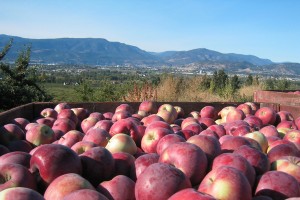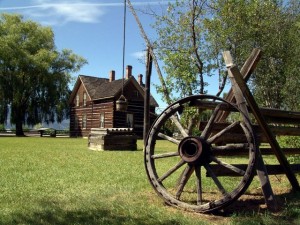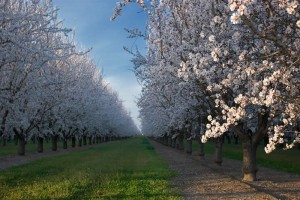 To me, agriculture, and in particular fresh, juicy apricots and peaches define the Okanagan. Before buying a place and planting some of my own trees, I would keep visiting the BC Tree Fruits store in anticipation of the first apricots, buying a box as soon as I could, and polishing it off within a week, largely on my own, before going back for the next one. Once the peaches arrived, same story. These fruits are what make my summer. To me, this place would truly lack something special if that local season of soft fruits wasn’t part of our year.
To me, agriculture, and in particular fresh, juicy apricots and peaches define the Okanagan. Before buying a place and planting some of my own trees, I would keep visiting the BC Tree Fruits store in anticipation of the first apricots, buying a box as soon as I could, and polishing it off within a week, largely on my own, before going back for the next one. Once the peaches arrived, same story. These fruits are what make my summer. To me, this place would truly lack something special if that local season of soft fruits wasn’t part of our year.
The city of Kelowna is in the process of updating its agricultural plan (Capital News). I think that this is an important opportunity for us to define the role that agriculture has in our community. There will be opportunities for public participation, and I hope that the citizens of our city choose to participate. In deciding what the role of agriculture is in our community, I think we need to face some important facts. I recently gave a talk that reflected some of these issues, with the slides available here.
Fact #1: Agriculture is only a small part of the Kelowna economy. Agriculture was a key industry in the settlement history of the Okanagan valley and in particular the city of Kelowna. However, the city has grown, and other industries have taken over. As reported by Statistics Canada, the share of the Kelowna population directly employed in agriculture is under 2%. The share of businesses involved in agriculture is less than 3.5%, and many of those are businesses that have no employees. Even if we are generous and say that each job in agriculture supports two jobs elsewhere in the economy, we are still talking less than 6% of jobs. Within Kelowna, agriculture is a small industry.
 Fact #2: We don’t need local agriculture to feed ourselves. We do need agriculture to feed ourselves. Farmers feed the world. However, that doesn’t mean the farms need to be nearby, such as within the urban boundaries of Kelowna. Over the long term, food prices have been falling, even as global populations have been increasing. Yield per acre and yield per person have been increasing everywhere in the world. Malthus’ predictions that the ability to produce food will be what eventually limits population growth – famine if pestilence and disease are insufficient – seems so far to have been kept at bay. Loosing the food production that occurs in Kelowna would have little discernible impact on food prices or food availability in the city.
Fact #2: We don’t need local agriculture to feed ourselves. We do need agriculture to feed ourselves. Farmers feed the world. However, that doesn’t mean the farms need to be nearby, such as within the urban boundaries of Kelowna. Over the long term, food prices have been falling, even as global populations have been increasing. Yield per acre and yield per person have been increasing everywhere in the world. Malthus’ predictions that the ability to produce food will be what eventually limits population growth – famine if pestilence and disease are insufficient – seems so far to have been kept at bay. Loosing the food production that occurs in Kelowna would have little discernible impact on food prices or food availability in the city.
Fact #3: Local agriculture has little relationship to food security. Food security is a term people like to throw around when talking about local agriculture. If we are talking about protecting our ability to produce food in the face of the risk of other suppliers not being available – drought in California being the recent example – then local food production contributes very little. This kind of food security is best addressed by ensuring that we have strong trade agreements that allow local food retailers access to multiple sources. If food security is about ensuring those on low income can acquire the food they need, then giving food to the needy would have to be the priority of local food producers. It isn’t. There are gleaners, and there are donations, but these are what happens when the farmer is unable to sell the crop. Local farmers are not growing crops to give them away. This kind of food security is best addressed by helping those on low income to increase their income.
Fact #4: Buying local is not better for the economy. What is good for the economy is producing the goods and services we consume at the lowest possible cost – which includes environmental costs. If agriculture is the most profitable use of local land, then we wouldn’t need the ALR, and we wouldn’t be perpetually worried about the loss of local farms and farmland. This ties to helping the poor. If one buys expensive produce from a local producer rather than lower cost produce at a big box store, then there is less money available to donate to helping the poor.
Fact #5: Buying local is not better for the environment. What is good for the environment is having the smallest total environmental impact from the goods we consume. This Freakonomics blog lays out nicely some of the issues. First, transportation is only a small part of the environmental impact of the food we consume. That means we have to compare the rest of the environmental impacts. If growing food locally requires more land, or more irrigation, or more fertilizer, or more pesticides, per kilo of product than what is needed to produce it elsewhere, then growing local may actually be worse for the environment than bringing in food products from those places that are best at producing them.
These are some pretty darn depressing facts for anyone who wants to have agriculture as part of our community. The upshot of these facts is that on the basis of economics or the environment, local food cannot be easily defended. If local food production and local agriculture is to be part of our communities, it has to be so for reasons that go beyond the simple economics of jobs and farm profits and the simple environmental arguments that local is automatically better for the environment. We need to think far more broadly about the part agriculture plays in our communities.
So, beyond food, what does agriculture provide in Kelowna?

Source: http://www.investokanagan.com/
Landscape: Orchards, vinyards, market gardens, and pastures with grazing animals are important parts of the visual landscape we enjoy here in Kelowna. Look at real estate agent websites, and it isn’t uncommon for that visual landscape to be something they ‘sell’.
Open Space: Agricultural lands are not developed lands. Being able to escape from the bustle of the city to nearby spaces is valuable to many people.
 Culture and History: While agriculture may presently represent a small part of the Okanagan economy, it was instrumental to the settlement of the Okangan by immigrants who arrived during the last couple of centuries. Maintaining a working landscape provides a connection with that history and our cultural heritage. A related issue is the importance of protecting lands that provide traditional indigenous foods, but that is a discussion for another day.
Culture and History: While agriculture may presently represent a small part of the Okanagan economy, it was instrumental to the settlement of the Okangan by immigrants who arrived during the last couple of centuries. Maintaining a working landscape provides a connection with that history and our cultural heritage. A related issue is the importance of protecting lands that provide traditional indigenous foods, but that is a discussion for another day.
Habitats and Environmental Services: Agricultural landscapes can be important habitats for natural species. They may need to be managed with these services in mind. However, if lost, so is this option.
 Connection with the Seasons: When agriculture is part of our landscape, we are exposed to the natural cycles that farmers live with. Seeing spring blossoms, summer irrigation, fall harvest, and winter pruning provides us with a deeper connection with the place in which we live. This is particularly true when we as a community make a concerted effort to integrate these seasons into the events and activities hosted as a community.
Connection with the Seasons: When agriculture is part of our landscape, we are exposed to the natural cycles that farmers live with. Seeing spring blossoms, summer irrigation, fall harvest, and winter pruning provides us with a deeper connection with the place in which we live. This is particularly true when we as a community make a concerted effort to integrate these seasons into the events and activities hosted as a community.
Farming ‘vicariously’: Many urban residents long to be involved with food production. Some are fortunate enough to own property and have the time to garden. Many others are not so lucky. However, farmers markets and other opportunities to interact with local agricultural producers provides urban residents an opportunity to be more connected to where their food comes from.
Building Community: I recently attended an event organized by the Central Okanagan Food Policy Council. A unifying theme among the presenters was that being involved with food production built connections between people, people who may never have interacted around any other issue. Food is one of the few topics which anyone, irrespective of education, affluence, race, etc. can share about.

Source: http://www.okanaganstables.com/
Recreational Activities: Wine tourism, agri-tourism, equestrian activities, etc. all take place on agricultural land, and activities like cycling and walking are often enjoyed in agricultural areas.
On a quarter section many kilometers from the nearest residence, these factors are likely not that important. In the rural-urban fringe they can be large. The agricultural land in Kelowna is land in the rural-urban fringe, and these non-food services that agriculture provides are important here. Some experts have taken to speaking about the ‘multifunctionality‘ of agriculture, to clearly acknowledge that agriculture provides much more than just food and fiber commodities. Some European nations recognize this multifunctionality explicitly and make it part of their policy goals (e.g. Switzerland).
The present agricultural plan does mention a number of these non-food services. However, it does not explicitly mention multifunctionality, nor does it make any effort to assess how important or valuable these non-food services are. A substantial thrust of the document is towards supporting agriculture as an industry, with some management necessary to deal with some of the negative challenges, such as wetland loss, that we seek to reduce. Can we clearly recognize the multifunctionality of agriculture, and take that multifunctionality into account when making decisions about land use conversion? Can we develop policies that identify and support those non-food services that local agriculture provides?
If you care about these issues, be sure to pay attention for the opportunities to make your voice heard.

 Follow
Follow
Food security is an issue at the local, regional, national and global levels and Canadian agriculture makes contributions to all of these. I would agree that if you take the city of Kelowna in isolation, the local contribution to food security is probably minimal. But if you extend the same approach to all the larger communities in BC with agriculture in their immediate vicinity, all of a sudden you would see a considerable effect on the food supply chain, especially if you look at all of the Lower Mainland.
Food security and planning for providing a relatively secure source of food supply is a long term endeavour that needs to consider matters like climate change, political situations, conflicts (within the region or global), demographics, etc.. Agriculture land that has been converted to other uses such as residential or industrial development can not easily be repurposed for food production when the need arises. Therefore, maintaining a certain level of production capacity, even if the immediate need does not seem apparent, is critical.
You claim that “If one buys expensive produce from a local producer rather than lower cost produce at a big box store, then there is less money available to donate to helping the poor.” This statement is a text book example of a “non sequitur”; How many people do you know who buy cheaper produce to be able to donate more to the poor? Most people I know would use the extra money for entertainment, travel, better housing, gambling, eating out, etc. instead of donating to the poor; so, really, it does not follow….
It would seem from your statement that the field of economics is not subject to the most basic rules of logic.
You list a number of other contributions that Agriculture makes to society at large, ecological goods and services being at the forefront. I fully agree with you here, even though your example of Switzerland needs some clarification.
Switzerland makes generous cash payments for ecological goods and services of around $35,000 per farm per year to maintain a healthy agriculture sector. While these direct payments are officially related to supporting ecological farm practices, the reality is that they are in place to secure a reliable supply of food for the country in case of need by keeping many small farmers in business. The last time there was a serious threat to food security for this country was during WW2.
In conclusion, even in the absence of a very substantial economic impact, agriculture’s contribution to the long term well being of the population should not be under estimated, even if you may not agree with the “buy local” movement that gets a fair bit of traction these days.
Thanks for the comments Hans. Kelowna’s agriculture plan is about Kelowna. Protecting our ability to produce food as a planet, in the face of challenges such as climate change, does require protecting enough agricultural land to meet global food demand. Given the trends in global food production, it seems that right now our technological innovation is allowing us to produce more food on less land. Can we be sure that our technology will always keep advancing and that we won’t be hit with some major surprise that seriously reduces our food production capacity? No. How much should we pay now as ‘insurance’, to reduce the impact should something go wrong? Protecting agricultural land and providing special economic treatment for farmers is the cost of this insurance. That cost is much higher if land near urban areas is protected for agriculture than it is if land far away is protected. When we are talking about agricultural land near Kelowna, I think we need to look for extra benefits to justify paying the extra cost.
Agriculture does contribute to the local economy. However, in many cases for land near urban areas, the direct monetary economic contribution of agriculture is less than the other uses to which that land can be put. In these areas, which applies to pretty much all of the agricultural land within the boundaries of the city of Kelowna, the basic economic contributions – farm profits, employment, etc. don’t make the case on their own. Add the other benefits, many of which actually increase as the city grows, and the total benefits of local agriculture may be enough to justify protecting local agriculture. We typically don’t know how big these other benefits are, but given public interest in local food, public support for the ALR, the fact that properties near open space (much of which is agricultural land) are, all else equal, worth more, etc., my guess is that these other benefits are pretty big.
I value having local agriculture here in Kelowna. I support the public desire to protect local agriculture. However, I find that some of the arguments people make in favor of local agriculture are not supported by the facts. I think people actually recognize these other benefits, but don’t know how to talk about them in a convincing way. I think we need to explicitly recognize the multifunctionality of agriculture here in Kelowna. The Europeans can do it. The Okanagan, and Kelowna in particular, is a region with a high population relative to arable land. We are much more like Switzerland than Saskatchewan, and I think we can learn from the Swiss and other European nations in the way that we support our agriculture and protect agriculture at the urban fringe.
Yes, I think “buy local” is a means to an end — ie. maintaining farmland — rather than an end unto itself. The beauty of it is that it is a meme people can hold onto and feel like they have some control over. I’ve worked on getting healthier food choices into schools — it was the responsible thing to do for a publically funded institution, and it’s good for learning, protecting children’s international human rights to health and an open future, and growing future community assets. But those arguments didn’t sway public opinion — it took more than a 20 second sound-bite to explain the philosophy and rationale and shift a very inert public paradigm of easy fundraising, at any cost! It was rising obesity concerns that finally got schools and governments on board. Childhood obesity was the meme — the 20 second sound-bite, that got us in the door, even though our original rationale was much more nuanced.
“Buy local” is the ALR’s 20 second sound bite. Incomplete, not completely rational, but effective in getting us from A to B.
I love your approach, even though it doesn’t completely synch with mine 🙂 You’ve presented a side of the agriculture/food security discussion that most of us foodies don’t typically acknowledge, and it’s important that we’re all aware of the pro/cons/opinions/facts for all sides of the topic.
I wonder about a few points though:
-if agriculture doesn’t have the best $ return for inputs/land-use per annum, does that mean it has less value? less value over time? My sense is that we preserve land for agriculture not just for economic or food security needs for today, but also for the future. Once land goes to development it is virtually lost for food production.
-yes California currently is very effective at growing and distributing the bulk of our produce, but can we rely on that? Trade/border issues, water shortages, fuel costs for distribution, mass contamination (accidental or sabotage), etc all make our link to this supply much more tenuous than our reliable-plentiful-affordable-grocery-store-mindsets typically think. One only has to look at the massive efforts during WWII to farm city parks etc to realize the importance of local land for food production during times of crisis and/or interruptions in distribution systems. Smart planners ensure they have back up plans at the ready — as much as I love horses and wine, turning acres used for those purposes into food production would take longer than required.
-GDP is not the ultimate measure of a country’s (or province’s, or region’s) strength. Take as an example breastfeeding — the more successful we are at this proven method of reducing health care costs, the lower our GDP (less formula sales, less pharmaceutical sales, etc)(this list can get really long when you look at all the ramifications). I expect the same is true for food production. A strip mall would contribute a lot more to the GDP in the short term. So would selling condos to Albertans and foreign speculators who leave them empty except a few months of the year. Again, is $ how we measure value? The tangibility of counting $s is tempting, but intangible factors shouldn’t be ignored.
Hopefully this adds to rather than detracts from your comments about the value of agriculture land, and what our agriculture plan needs to consider and reflect. All your economic points are important to consider, along with these and other intangible & proactive considerations.
Thanks for the comments Cathy. I agree with much of what you say, and appreciate your contribution. Producing food within our communities is, IMO, not just about economic or environmental benefits. Multifunctionality is a big, technical sounding word that probably doesn’t make for much of a sound bite. I wonder if there is a better way to capture the idea that agriculture provides much more to our communities than food?